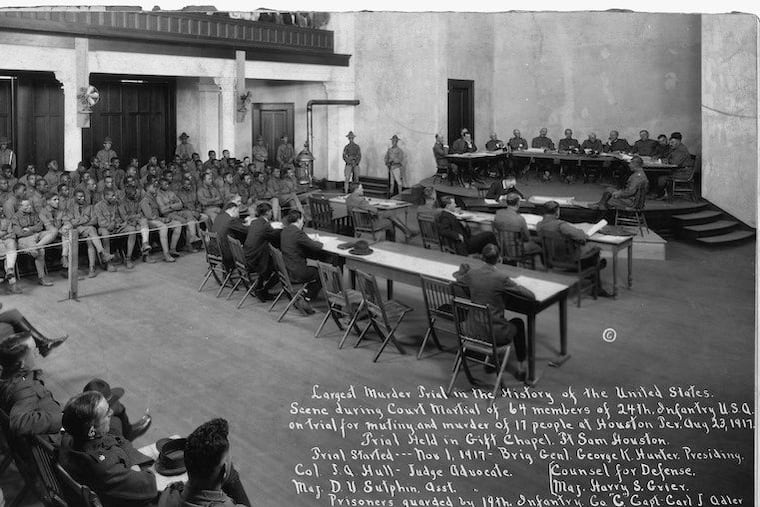When black soldiers fought back against police brutality 100 years ago in Texas
On Aug. 23, 1917, in Houston, 156 members of the all-black 3rd Battalion, 24th Infantry went on a racially charged rampage that took the lives of four soldiers and 15 white civilians.

Aug. 23 marks the 100th anniversary of a watershed moment in race relations in the United States. On this day in 1917, in Houston, 156 members of the all-black 3rd Battalion, 24th Infantry (famously known as the Buffalo Soldiers) went on a racially charged rampage that took the lives of four soldiers and 15 white civilians. It remains the only race riot in U.S. history in which more whites than blacks were killed.
Four months later, after the largest court martial in the nation's history, 13 black soldiers were summarily hanged at Camp Travis, San Antonio. Observers at the court martial said — and historians later confirmed — there was no reliable eyewitness testimony that any of the executed men participated in the riot.
Sixty-three other members of the 24th Infantry received life sentences. In September 1918, six more black soldiers — who witnesses said had fired on white civilians — were also hanged.
The arrival of black troops in Texas in 1917, the height of the Jim Crow South, was ill-advised. In preparation for World War I, the Army decided to build 32 training facilities across the country. Houston won a $2 million contract to construct one of the camps.
City fathers requested that no black soldiers be stationed in Houston. Many whites feared the sight of armed black soldiers would provoke among "local blacks … a desire for better treatment," according to an unattributed report on a Prairie View University historical link. Black soldiers believed their service should result in civility from local whites.
Although Houston officials promised there would be no racial trouble, the police department was well-known for its abuse of blacks. Within days of their arrival, black soldiers began to refuse to take seats at the back of Houston public transport trolleys. These acts soon were labeled "insolence" by white Houstonians and predictably led to harsh treatment from police.
On the night of Aug. 23, the Chamber of Commerce had planned a "watermelon party" for the black soldiers. Instead, a race riot ensued. Trouble started that morning when police officers Lee Sparks and Rufus Daniels (both known for their brutality against blacks) pursued a man accused of participating in a dice game into the home of a local black woman.
They arrested the thinly clad woman and accused her of hiding the gambler. When a black soldier asked Sparks if he could get clothes for the woman, Sparks pistol-whipped and arrested him.
Later that afternoon, Cpl. Charles Baltimore of the 24th inquired about the soldier's arrest. He too was beaten by Sparks and fled when fired upon. Baltimore was caught and taken into custody.
Rumors that an angry white mob was heading to Camp Logan soon reached the soldiers. Although ordered to stay inside their barracks, the black soldiers broke into a supply tent, took weapons, and began firing randomly into the night after someone shouted, "Here they come!"
More than 100 soldiers headed for the police station to liberate their comrades. Historians believe they were led by First Sgt. Vida Henry, who initially tried to dissuade the soldiers from seeking retribution but eventually joined them. One of the first victims of the night was a white child, felled by a stray bullet.
Another casualty was Capt. J. Mattes of the 2nd Illinois field artillery. The soldiers dragged him out of a car and shot him, believing him to be a policeman. Soon after realizing their mistake, the rioters began to disperse. Henry, the ostensible leader of the mutiny, died of self-inflicted wounds.
The next day, 118 black soldiers were arrested, charged with murder and mutiny, and moved to a stockade to await court martial.
It is easy to look back on events of 100 years ago and see how the racial taunts of Houston's white residents and policemen created a climate of abuse that led to the soldiers' mutinous behavior. No one can defend what those soldiers did that tragic night. Neither can we ignore the fact that some of the initial 13 executed soldiers paid the ultimate price for crimes they may not have committed. In the Army's rush to judgment, they were scapegoats, used to send a message to American blacks that violence would only beget more violence.
Most Americans today believe that blacks and whites can live in harmony and that all Americans, regardless of their race, religious affiliation, sexuality identity, or social class, should have the same opportunities to a life of peace and prosperity.
When President Trump recently refused to criticize hate groups for the violence in Charlottesville, Va., he was met with public rebukes from the four leaders of our military branches. This shows a different military from the one in Houston in 1917, and how far the nation has come in the century since racial tensions in a Southern city turned tragic.
But the events in Charlottesville themselves, and the disagreements about how to deal with our still-festering problem of racial bigotry, also show how far we have to go.
Chuck Bauerlein is a professor of journalism at West Chester University. cbauerlein@wcupa.edu